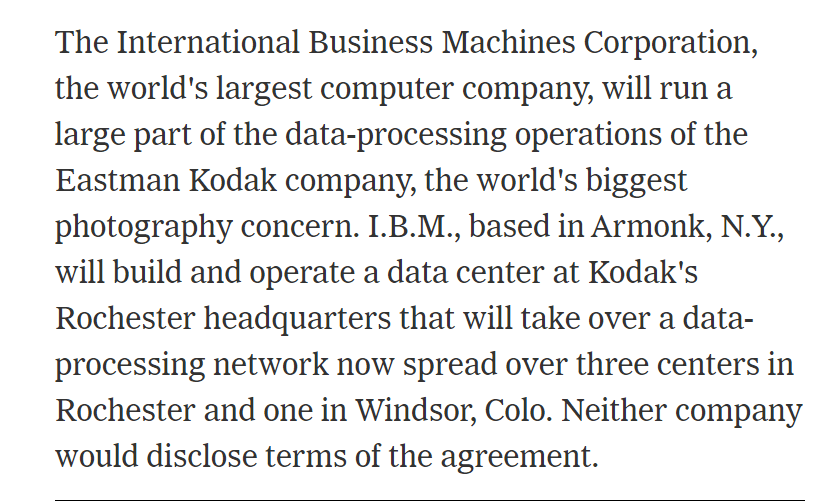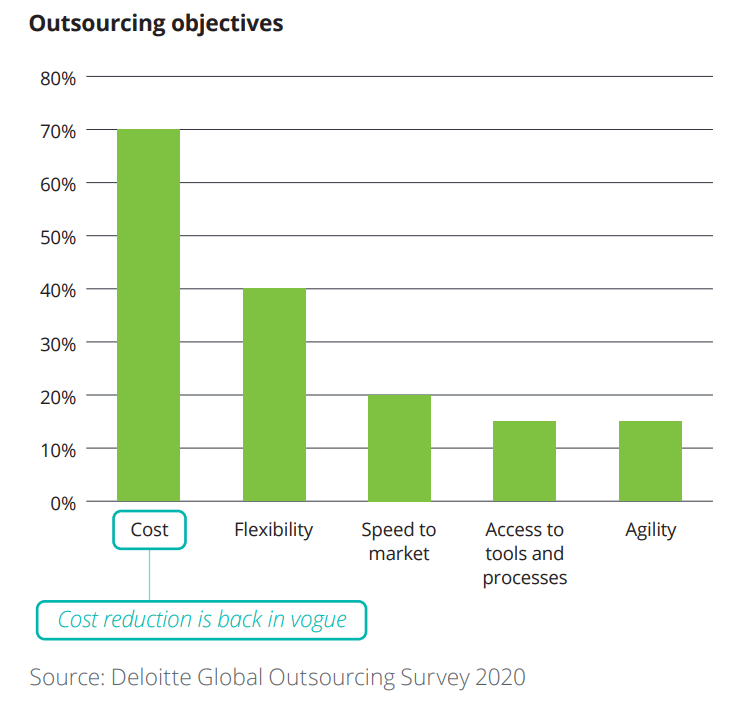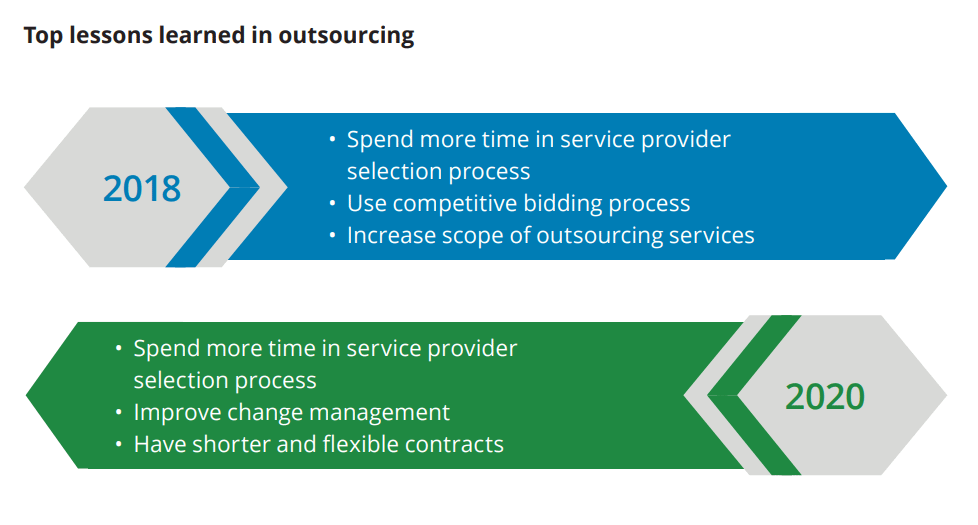Did you know that logistics managers, soldiers, and pirates were some of the first outsourced employees in human history?
It’s true.
Outsourcing has evolved a lot over the years. We’ve gone from humble tradespeople in ancient times to workers in the Industrial Revolution, where manufacturing jobs were outsourced to keep up with demand and stay in step with the competition.
And shifting over to the 20th and 21st centuries, where economic progress has given us the Internet and ways to communicate instantly, outsourcing has shaped our lives whether we think it’s taboo or not.ser
To understand where outsourcing is today and where it’s going, let’s first look at what outsourcing really means and what types of outsourcing there are.
What is Outsourcing?
The dictionary definition is: “to procure (something, such as some goods or services needed by a business or organization) from outside sources and especially from foreign or nonunion suppliers: to contract for work, jobs, etc., to be done by outside or foreign workers.”
And the first usage of the term can be traced back to 1979. But, as we’ll learn, this is only true for the word, not the meaning behind it.
Entire books have been written about outsourcing (exploring both the good and bad), and we had a chance to look at some of them in-depth to really get to the roots of outsourcing.
Is Outsourcing Good or Bad?
The average Joe thinks of outsourcing as a bad thing.
And the average critique looks something like this:
- “You’re taking jobs from us, and shipping them overseas!”
- “Execs only care about the bottom line.”
- “Outsourcing only works if it’s insourcing/onshoring/domestic.”
- “Outsourcing causes brain drain and excessive spending in the long run.”
Yes, it’s true that, more often than not, outsourcing is done to save money, and it’s also true that many outsourcing endeavors fail because of pitfalls and challenges associated with giving someone else the keys to (part of) your business.
6 IT Outsourcing Challenges: A Raw and Unbiased Critical Look
But if it’s done properly, offshoring, nearshoring, or any other offshoot of outsourcing can be a great advantage. For example, when you can’t find the talent locally, you can look outside your immediate surroundings to get the help you need.
And the most important takeaway here is that with outsourcing, you get what you pay for. Cutting corners to an extreme degree will likely result in frustration, failure, or both. Now that we know the difference between “good” and “bad” outsourcing let’s look at the three main types of outsourcing.
Few people know that outsourcing is an umbrella term. It includes onshoring, offshoring, and captive offshoring.
Types of Outsourcing
- Onshoring (aka domestic outsourcing) — This is where IT outsourcing got started. Onshoring implies hiring (or partnering) with someone located within the same country as you.
- Offshoring (aka international/foreign outsourcing) — Offshoring is what you’re most likely familiar with. This involves transferring some part of your business to another country.
- Nearshoring — This is offshoring with a twist. Instead of looking for someone thousands of miles away, you look to neighboring countries for outsourcing services.
- Captive (aka direct-hiring/R&D center abroad) — Captive outsourcing is where you hire people, teams and possibly set up offices abroad. The difference between this and offshoring is that the employees you hire are part of your organization.
Now with the somewhat boring stuff out of the way, let’s look at outsourcing’s history. We’ll try to keep it as brief as possible.
A Brief History of Outsourcing
Outsourcing booms in history happened for many reasons, but modern booms can be traced to temporary economic turbulences that created a permanent change. As we’ll show, examples include Y2K and the turn to remote work in 2020.
Let’s not skip ahead to modern times just yet.
First, let’s look at where outsourcing got started.
Pre-Industrial Revolution
It’s impossible to pin down the exact moment in time when outsourcing was invented. Logically speaking, it’s inevitable that one person or people had skills that others didn’t, and those skills, or the product of those skills, could then be traded.
If something was subcontracted — you can consider that outsourcing.
The earliest example can be found in the Bible. As Ken Ackerman, author of Warehousing Profitably, wrote, the people of Egypt outsourced distribution of stockpiled crops during the seven years of famine (Genesis, Chapter 41).
Fast forward to the Middle Ages, where the organization of work and trade began evolving. Manufacturing and logistics could be outsourced just as well as any other skilled trade.
Pirate crews and transoceanic voyages outsourced crews and logistics to make the arduous journey on a limited budget. Adventurous captains could cut costs by hiring cheaper crew members in less-developed countries along the way.
Military outsourcing also came about at some point in history. Any mercenary or hired soldier can be considered an outsourced worker. Obviously, this trend has continued to our day and age, with private military companies fighting in wars.
20th Century Outsourcing
The dawn of the 20th century brought massive changes in how people worked, which included outsourcing. Many authors and writers cite Automatic Data Processing (ADP) as one of the most significant outsourcing disruptors in the 20th century. Although it has a generic name, ADP had a unique value proposition — they were experts in payroll, taxes, and accounting.
ADP offered their services to the US government and private companies, taking the stress of calculating expenses and taxes out of the equation so that those entities could focus on other things.
In the 1950s and 1960s, outsourcing continued gaining traction. As the world turned to science and technology, it became evident that keeping everything within a single organization would be next to impossible.
This time period also forged IT and software development as major drivers of change. It’s time to look at the first case of IT Outsourcing in History.
The First Case of IT Outsourcing in History
Can you think of a more positive disruptive force in the last 100 years than IT?
We won’t go into a tirade about how 5G towers are everywhere, and smartphones listen to what you say — you already know all that.
Where did IT outsourcing get started? We’re confident there were cases before Electronic Data Systems (EDS), but the consensus is that it was the first major IT outsourcing provider.
H. Ross Perot headed up EDS., and it was thanks to his entrepreneurial spirit that EDS became a pioneer in managing IT facilities for banks, financial institutions, corporations, and government offices.
In 1967, an EDS employee named Morton Meyerson proposed a business model that eventually became known as outsourcing. And one last thing about EDS — it continued providing and improving its IT services until General Motors bought it in 1984 for $2.5 billion.
The 1980s and 1990s

Outsourcing and IT outsourcing, in particular, took off when Kodak decided to outsource data processing to IBM. IBM built Kodak a data center back in 1989 (New York Times covered this at the time).
This game-changing deal showed other major corporations the benefit of the doubt regarding outsourcing (in this case, onshoring). IT outsourcing saw rapid growth, and organizations began following suit.
In the 1990s, outsourcing gained the taboo or stigma status. Outsourcing in the 90s was predominantly done for cost-saving purposes. Understandably, no one likes losing their job, especially if it means someone in some faraway country gets your job instead of you.
Y2K and India’s Outsourcing Empire
Y2K…is that like a disease or something?
For some of you reading this, Y2K will bring back flashbacks of fear and anxiety over what would happen when the clock struck midnight.
For those that don’t know what Y2K was, here’s a refresher:
Y2K was a computer bug that had the potential to cause many problems beyond the date of December 31, 1999. The reason is, software engineers back in the day had limited storage space, and (to cut costs) they decided to shorten dates to just two numbers. That meant when the clock struck 12:00 am on New Year’s, the digits in most private and public companies’ computer programs would read “00.”
The JavaScript .getYear() method problem
IE9+, Google Chrome, Firefox, Opera, Safari, etc. | |||||
Real year | 1858 | 1990 | 1994 | 2000 | 2007 |
.getYear() result | -42 | 90 | 94 | 100 | 107 |
FullYear() result | 1858 | 1990 | 1994 | 2000 | 2007 |
IE6-8 | |||||
Real year | 1858 | 1990 | 1994 | 2000 | 2007 |
.getYear() result | 1858 | 90 | 94 | 2000 | 2007 |
FullYear() result | 1858 | 1990 | 1994 | 2000 | 2007 |
It’s hard to imagine how much time and money was spent fixing the Y2K bug. An archived Washington Post article states that it cost over $100 billion.
What was all the money spent on, and how did we avoid a global catastrophe?
One man’s bug is another man’s treasure
Y2K was the perfect catalyst for India’s budding IT outsourcing market.
Upon discovering the Y2K bug, everyone rushed to fix it, working day and night. Unfortunately, that wouldn’t be enough. So, the US and other nations turned to India, among others. But it was India that was at the center of attention.
Why India?
Access to hundreds of thousands of talented experts allowed the rest of the world, and the US in particular, to get out of Y2K relatively unscathed. Y2K contracts positioned India to become a global leader in software and IT outsourcing.
We won’t deny that cutting costs was the primary motivator, as an archived CNN Money article stated back in 1999, “Indian programmers make roughly $9,000 per year, less than 1/6th the salary earned by their American counterparts.”
And the rest, as they say, is history.
India still holds a top position in the global outsourcing market today.
The 2000s & 2020’s Role in the Evolution of Outsourcing
In the 20 years between Y2K and 2020, outsourcing skyrocketed. You can imagine why — technological progress. And we’re not just talking about Internet speeds. The evolution of business processes, methodologies (the Agile Manifesto was published in 2001), cloud, industry disruptors, and VCs, is generating a new era of tech.
And that tech requires talented engineers. To find those engineers, companies look abroad, and outsourcing seems like a great option to speed up time to market.
Outsourcing drivers and enablers ebb and flow with what the market needs. For example, in 2020, outsourcing objectives shifted from agility, quality, and scalability to cost reduction, flexibility, and speed to market (see graph below).

At first, this may seem like a contradiction (Deloitte cites this in the survey), but having done a ton of research, it makes perfect sense. Here’s why: when the pandemic hit, business leaders had to make tough decisions. Not only did they have to move fast, but they also had to do it in a smart way.
And judging by the Deloitte survey, the respondents looked to outsourcing to reduce costs, have flexible contracts, and move faster. Again, logical, but the way these driving factors change over time allows us to extract important lessons YoY.

The issue we see with traditional outsourcing (offshoring or onshoring) is that your financial stability and well-being are tied in with another company. During the pandemic, we saw just how many clients noped out of their contracts, which caused a cascading effect on outsourcing providers. Software engineers were let go, and some vendors were forced to close their doors for good.
Takeaways: The Next Step in Outsourcing
We’re slightly biased in saying that captive offshoring — the model where your company directly hires employees and sets up offices abroad — is the best way forward.
Instead of spending countless hours searching for a vendor, not seeing the results you want, and frustrating your employees, why not vet, onboard, and train people that fly your flag, work directly for your company, and are incentivized to become truly passionate about your product?
Contact Bridge for more info on how to cut out the middleman.




